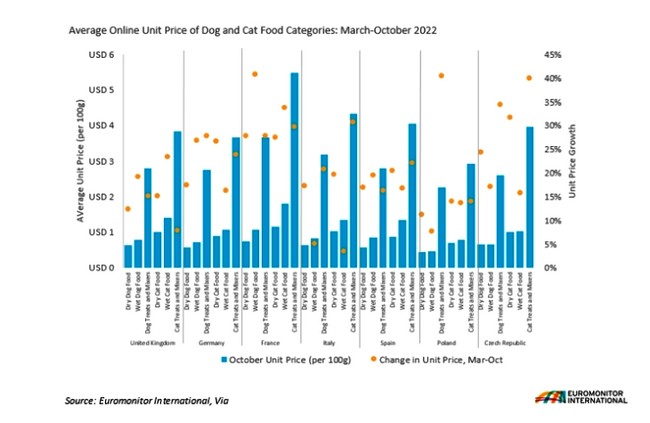In the first quarter, the GDP had stagnated, after having even shrunk by 0.1 per cent in the final quarter of 2022. Economists expected growth of 0.2 per cent on average. The Eurozone thus narrowly avoided a technical recession, i.e. two negative quarters in a row. However, the economy was slow to develop over the winter.
France and Spain in particular contributed to growth with increases of 0.5 and 0.4 per cent respectively. The Irish economy displayed especially strong expansion at 3.3 per cent, although its growth is regularly overstated due to special effects.
In the meantime, inflation in the Eurozone continues to recede. In July, consumer prices increased by 5.3 per cent compared with the previous year, after a 5.5 per cent increase in the preceding month. This is the lowest inflation rate since the beginning of 2022.
The availability of dog and cat food products in Europe has been significantly impacted by supply chain disruptions and increasing competition for commodity goods due to the ongoing war in Ukraine. Online retailers of these goods have struggled to maintain consistent availability during this time, which has placed additional burdens on pet owners who see rising costs for their pet food alongside their own purchases.
While the UK, the largest market by pet food sales in Europe by 2021 RSP terms, saw only an 8% decline in the number of available SKUs during the 8-month period of observation, Germany and France have experienced a more challenging environment of product procurement as they are in closer proximity to the war in Ukraine, with these countries' online markets seeing available SKUs drop by 39% and 35%, respectively.
Poland and Czech Republic have seen an increase in refugees from impacted areas, which has placed additional demand on the pet care supply chain environment. Refugees have brought along companion animals, considering the importance that pets play in supporting refugees' mental health. As highlighted in the above graph, the online availability in these two countries in particular has, with the added pet populations, left retailers' online shelves the most reduced. These additional pet populations are another added challenge, as suppliers and retailers deal with supply chain disturbances of both finished products and raw materials sourced from Ukraine and Russia.
France sees highest online increase in pet food prices
Availability of goods is a strong driver of price increases. As the majority of markets have experienced a drop in availability, unit prices have drastically risen. Breaking out the individual dog and cat pet food categories reveals the extent of price increases that consumers are experiencing through this 8-month period. Standardising all online SKUs into per 100g units reveals just how much prices are rising across all SKUs and underscores the challenging decisions pet owners are experiencing while shopping for their favourite companions.

By standardising to a per unit comparison, inflationary impact on consumers can be truly observed regardless of how companies and retailers are adjusting pack sizes and types within their portfolios. While the average unit price increases for these seven countries, and the six individual pet food categories being tracked, reached 21%, France experienced the strongest increase in unit prices of all countries with an average rise of 31% for the six cat and dog categories.
Inflation in these categories has had dire consequences, especially in France, where the animal protection group La Société Protectrice des Animaux (SPA) announced that abandonment levels of dogs are up by 6% this year through to August and that its shelters were completely full. Many pet owners are simply unable to bear the additional costs alongside other expenses and are in turn abandoning animals as well as delaying adoption and rescue plans.
by EuroStat
All Pet Food
You could be interested: Impulse Purchases Still Strong
Market Information
07/08/2025
The American Pet Products Association (APPA) Releases 2025 Dog & Cat Report, Revealing a New Era of Pet Ownership
29/07/2025

















































